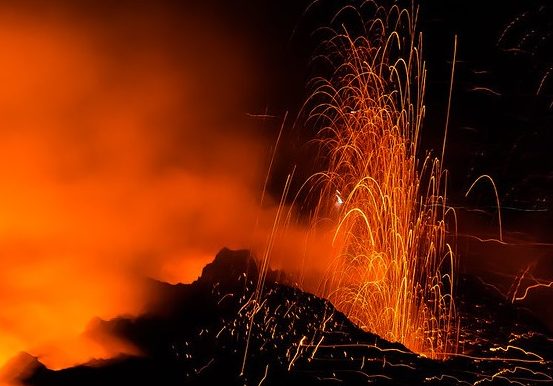A Very Volcanic Fourth of July

Look, human-made fireworks are pretty. And I enjoy them! Sometimes. When the forest isn’t crispy from an overly hot, dry summer and ready to catch on fire from so much as a heated word. And when I don’t have to battle crowds to see them. And when I don’t have to hear all the noise, which is becoming less and less entertaining as I get older.
Okay, so I like them on television, at my home, with the sound off, okay? Then I love them a lot. They’re very pretty!
But as impressive as some human pyrotechnic displays are, they just can’t quite measure up to the show an erupting volcano can put on. So for this July 4th, I’m going to take you on a world tour of volcanic light shows, courtesy of some very talented photographers.
Italy’s Stromboli volcano has put on a show for at least two thousand years, and probably longer. I promise we’ll be swinging by there when we restart our tour of the Mediterranean. It’s a superb and fascinating volcanic island with a ton of history behind it!

Mount Vesuvius in eruption, probably in the late 1770s. The artist isn’t listed, but it’s likely either Pietro Fabris or J.M. Mixelle. Credit: Wellcome Trust (CC BY 4.0)
Vesuvius in eruption over the Bay of Naples. I love how the artist has captured the energy of volcanic lightning in the eruption cloud. This is another one we’ll be visiting soon! And we’ll have a special series on Pompeii and Herculaneum.
How about an eruption and starry skies? Guatemala’s Volcán Fuego put on a lovely show in March of 2013. This is a subduction zone volcano, but oddly prefers erupting basalt. We may have to go investigate!
Beautiful, but so much orange, you say? Fireworks come in many colors? Indeed, and this is an excellent point! Don’t worry; I have this handled:
Arenal is proudly in the top ten of volcanoes with the longest eruptions in modern history, with a sustained 42 years of eruptive activity from 1968 to 2010 before it took a well-deserved rest. This image isn’t an eruption. It’s actually probably heavily photoshopped. However, lightning storms over volcanoes with or without an eruption can be bloody spectacular, and this is a fitting homage.
But hey, if you want the real thing, I’ve got it.
So this looks like a large volcano, yes? A large volcano generating huge lightning? It is huge lightning, but this volcanic cone is dwarfed by its parent. Your mind is going to boggle when you look at Mount Rinjani in daylight.
Eyjafjallajökull generated some truly spectacular lightning shows during its 2010 eruption. (Fun fact: this volcano not only disrupted air traffic for most of Europe, but it used to be part of the Icelandic coastline! Isostatic rebound has raised the Icelandic landmass since the end of the last Ice Age, and the coast is now three miles away.
Volcanic lightning is a trip. Ethan Siegal wrote a marvelous article about it that has many more incredible images, and you should absolutely go check it out.
But we want some more color, don’t we? How about some blue lava?

Burning sulfur gas creates spectacular blue flames at Ijen volcano complex in Indonesia. Credit: tonynetone (CC BY 2.0)
All right, it isn’t actually lava – it’s sulfur gas, burning in the night. This is so nice we gotta look at it twice:
Ijen volcano complex has some of the most spectacular scenery on the planet. Even in daylight, it’s lovely, but at night it’s simply ethereal.
This blue “lava” may look cool, but it’s over 600°C (1,112°F), so definitely please don’t try to go swim in it.
Every fireworks show should end with a grand finale. We’ll have Stromboli begin the final display:
And no Fourth of July volcano display is complete without a lava whirlwind. Talk about sparks flying!
Play us out, Kilauea:
Enjoy your day, my darlings!







